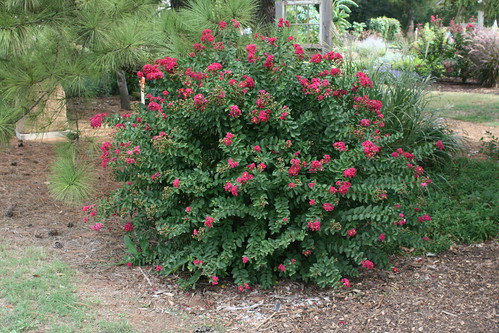Lagerstroemia Indica (I) by .Bambo.
I love Crape Myrtles Lagerstroemia indica (the American Horticulture Society spells it Crape ) and they love hot weather. With the weather we have been having this summer, they have been in their glory. Another good thing for Crape Myrtles is these dry summers; because once established, Crape Myrtles tolerate some drought. In fact when Crape myrtles were brought to the States from China, they were happiest in the South or USDA Hardy Temperature zones 7 through 9 or perhaps 10 or 11. They didn’t bloom in cooler climates.
Fifteen years ago, I don’t remember seeing many Crape Myrtles in Zone 6. Those few who had them seemed to grow them outdoors in sheltered areas or else they overwintered them in greenhouses. But these days I see Crape Myrtles perennially growing in many yards all over my area. Crape Myrtle breeders had been busy at work creating the Crape Myrtles for Zone 6 so that now everyone in zone 6 seems to have a Crape Myrtle decorating his or her yards.
My Crape myrtle is a baby from a friend who has a Crape Myrtle in almost every color in her small, but very lovely garden. Crape Myrtles have so many seeds from all the flowers, that if you have the right environment, even if you are not a plant hybridizer, you may find new babies in your yard from your main Crape Myrtle.  See here.
Dwarf crape myrtle by Gardening in a Minute
When I visited my friend’s garden most recently, I saw her newest Crape Myrtle acquisition flowering in her garden. It was a charming dwarf Crape Myrtle!
These days, as in my friend’s garden, one can buy Crape Myrtles that are 1 ft tall to 25 feet tall. You can find different heights for every size garden.
The exciting thing about some of these tiny or dwarf Crape Myrtles is that they can be grown from USDA hardy Temperature Zones 4 through zone 11. These dwarf Crape Myrtles are “hardy for the east and north and tested to -30 degrees Fahrenheit for over ten years.” This allows more lovers of the Crape Myrtle to enjoy them and yours can enjoy more landscaping possibilities. You can grow these dwarfs in planters and easily take them in over the winter. Or now you can plant them outdoors permanently.
Growing instructions are : “Full sun -at least 6-8 hours a day in the Midwest, north, east and Northwest but can take partial shade in the South and Southwest. Plant in well-drained soil, water it in well and let it dry out 4-6 inches down between waterings. It is a true dwarf plant, thus it needs less water.”
Check out these two sites:


